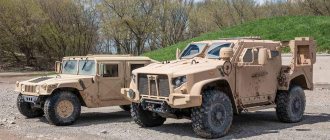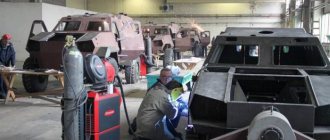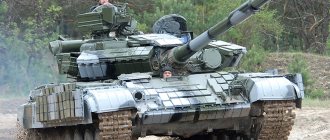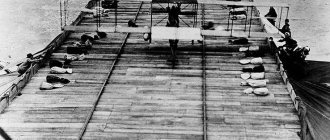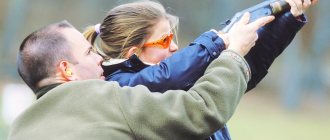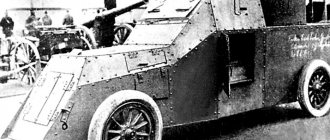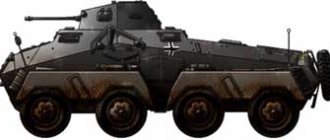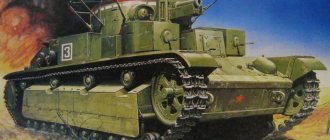History of the creation of the BTR-40
In 1947, in the design bureau of the Gorky Automobile Plant under the leadership of V.A. Dedkov and leading designer V.K. the GAZ-63 truck, began the development of a light armored personnel carrier called “ Object 141 ”.
In 1948, two prototypes of the armored personnel carrier were ready, one of them was made with a fully armored hull and turret installation. Based on the results of factory tests, it was decided to prepare an open-top version of the car for presentation to the state commission and subsequent mass production.
An armored personnel carrier called the BTR-40 was adopted by the Soviet army in 1950, and in the same year its mass production began at the Gorky Automobile Plant. The BTR-40 quickly gained popularity among the troops and was used as a vehicle for a motorized rifle squad, a reconnaissance patrol vehicle, and a tractor for anti-tank guns. It was unpretentious in operation, easy to maintain and had fairly good characteristics, generally meeting all military requirements.
Drawing of BTR-40
Operators[edit]
Map of BTR-40 operators in blue with former operators in red
Current operators[edit]
- Cuba: 100 [ link
] - Egypt: 380; 350 BTR-40 and 30 SPV-40Ch [ link
] - Ethiopia: 100 [ citation needed
] - Guinea: 16 [ citation needed
] - Guinea-Bissau: 15 [ citation needed
] - Indonesia: 100; [7] 85 in working order. [9]
- Iran [10]
- Laos: 10 [ citation needed
] - Nicaragua: 20 [ citation needed
] - North Korea: 450 [ link
] - Syria: 200 [ link
] - Tanzania [3]
- Vietnam: 100 [ link
] - Yemen [3] [11]
Former operators[edit]
- Afghanistan: 100 [7]
- People's Republic of Albania: 253
- Algeria: 100 [7]
- Angola: 32 [7]
- Botswana: 3 [12]
- Burundi: 16 [7]
- Cambodia
- People's Republic of Bulgaria: 150 [7]
- Type 55
variant developed ; [7] retired in the 1990s. [8] - East Germany: 300 [7]
- Hungarian People's Republic: 200 [7]
- Israel: Used by the Israeli Border Police. [13]
- Mali: 15[7] discharged from service before 2011. [14]
- Mongolian People's Republic: 200 [7]
- Mozambique [15]
- Polish People's Republic: 400 [7]
- Somalia: 60 [7]
- Soviet Union [3]
- Uganda: 60 [7]
- North Yemen: 70 [7]
- South Yemen: 60 [7]
- Yugoslavia: 40 [7]
Former non-state operators[edit]
- Palestine: Used by Palestine Liberation Organization (PLO) guerrilla groups and Palestine Liberation Army (PLA) units in Lebanon.
Modernization and further service of the BTR-40
In 1951, on the basis of the BTR-40, the BTR-40A was produced, on which the ZPTU-2 anti-aircraft gun and a pair of 14.5-mm KPV machine guns, capable of hitting both air and ground targets, were placed in the airborne compartment.
In 1956, taking into account the experience of military operations in Hungary, it was developed and produced until 1960. a variant of the BTR-40B vehicle with a fully armored hull.
In 1957, the BTR-40V vehicle, equipped with an external system for regulating air pressure in tires (self-inflating system), was developed and produced in a small series in order to increase the maneuverability of an armored personnel carrier.
Since 1957, the BTR-40РХ chemical reconnaissance vehicle, equipped with radiation and chemical reconnaissance devices, was produced. In appearance it was practically no different from the base model.
Also based on the BTR-40, a BRDM was created.
It was exported to the Warsaw Pact countries, Israel, as well as most pro-Soviet African republics and countries of Southeast Asia.
The production of the BTR-40 armored personnel carrier was carried out from 1950 to 1958; it was withdrawn from service only in 1993.
Description[edit]
Review[edit]
The design of the BTR-40 was based on the GAZ-63 all-wheel drive truck, which went into production in 1946. The design used a self-supporting body, which was a new feature of Soviet cars. The hull has two side doors for the commander and driver and a rear door. The vehicle can carry up to eight fully equipped soldiers or 1 ton of cargo.
Defense[edit]
The armor of the BTR-40 is 6 to 8 mm thick, which provides protection against small arms fire and shell fragments of the time, but does not protect against modern artillery fragments and .50 caliber machine gun fire. BTR-40 tires are not protected by armor. They are especially vulnerable to punctures from any type of fire. The vehicle has no roof and is usually covered with a tarpaulin to protect the crew, cargo or troops being carried from rain and snow. However, this makes it impossible to install any SGMB machine guns.
Weapons [edit]
The APC variant has no permanent armament, but it does have a tow mount for three 7.62 mm SGMB medium machine guns, one on the front of the troop compartment and the other two on the sides. The vehicle also has two firing ports on either side of the hull, allowing up to four soldiers to use their weapons while protected by the APC's armor.
Maneuverability [edit]
Like the GAZ-63 truck on which it is based, the BTR-40 has all-wheel drive. The chassis, however, is shorter compared to the GAZ-63. The only thing that distinguishes the BTR-40 chassis from the GAZ-63 chassis is the additional shock absorbers. The BTR-40 also has a more powerful engine. Rotation angle 7.5 m.
Equipment [edit]
The vehicle has a 10RT-12 transceiver radio station with a range of 20–25 km and a winch in the front with a maximum lifting capacity of 4.5 tons and 70 m of cable. It has no protection against nuclear, biological and chemical weapons. It also does not have night vision equipment.
Characteristics of the BTR-40 armored personnel carrier
A country:USSRType:Armored personnel carrierDate of issue:1950Length:5000 mm (body)Width:1900 mmHeight:1830 mmArmor, forehead:7 - 15 mmArmor, side:7 - 15 mmArmor, tower:7 - 15 mmCrew:2 people + 8 paratroopersEngine:GAZ-40, 78 hpTravel range:285 kmMaximum speed:79 km/hWeight:5.3 tonsWeapons:1x 7.62 mm SGMB machine gun (1250 rounds)
source: compilation based on materials from open sources on the Internet
Content
- 1 History of development
- 2 Description 2.1 Overview
- 2.2 Protection
- 2.3 Armament
- 2.4 Maneuverability
- 2.5 Equipment
- 3.1 Soviet Union
- 4.1 Former USSR
- 5.1 Current operators
Excerpt from the book Domestic armored vehicles. XX century: Scientific publication: / Solyankin A.G., Zheltov I.G., Kudryashov K.N. /
Volume 3. Domestic armored vehicles. 1946-1965 - M.: LLC Publishing House “Tseykhgauz”, 2010. - 672 pp.: ill.
The BTR-60P (GAZ-49) armored personnel carrier was intended to transport infantry troops and was in service with rifle divisions. It was created at SKB KEO GAZ under the leadership of deputy chief designer of the plant V.A. Dedkova The leading designer of the machine was E.M. Murashkin. The armored personnel carrier was adopted by order of the USSR Minister of Defense dated November 13, 1959. Serial production of the vehicle was carried out at the Gorky automobile plant in 1960-1963, one vehicle, assembled using the hull preserved at the Vyksa plant, was transferred to the customer in 1964, a total of 2626 vehicles were manufactured. The armored hulls were produced by the Vyksa Crushing and Grinding Equipment Plant.
The BTR-6011 armored personnel carrier was a combat wheeled, four-axle, floating armored vehicle with all drive wheels, armed with a 7.62 mm SGMB machine gun. It had high dynamic qualities, high cross-country ability and good smoothness. The armored personnel carrier could follow directly behind tanks and immediately overcome trenches, trenches and water obstacles.
The general layout of the armored personnel carrier was made with a front location of the control compartment, a central location of the troop compartment and a rear location of the power plant compartment. The combat crew consisted of two crew members (commander and driver) and 14 landing members. In the control compartment, the driver’s workplace was located on the left, and the commander’s on the right. In front of the commander and driver, there were inspection hatches in the front hull plate, which were closed with armored covers. Observation devices for the commander and driver were mounted in the hatch covers. In the stowed position, the inspection hatch covers could be open, and windshields could be inserted into the hatch openings. Above the inspection hatches in the upper part of the front plate there were two round cutouts into which TKN-1 night vision devices were installed on the right for the commander and TVN-2 on the left for the driver.
Armored personnel carrier BTR-60P.
Combat weight - 9.8 tons; crew - 2 people, landing force - 14 people; weapons: machine gun - 7.62 mm; armor protection - bulletproof; power unit power - 132 kW (180 hp); maximum speed: on land - 80 km/h, afloat - 10 km/h; wheel formula - 8x8.
Armored personnel carrier BTR-60P (view on the starboard side)
Armored personnel carrier BTR-60P (longitudinal section).
In the troop compartment, open at the top, along the sides there were transverse and inclined racks for attaching hard bench seats and backrests for the troops. To protect from the effects of precipitation, the open-top habitable compartments were covered with a tarpaulin awning. Transmission units were placed between the floor of the habitable compartments and the bottom of the hull. The power plant compartment housed two engines and systems that ensured their operation. The adopted general layout scheme provided the necessary constant trim of the vehicle to the stern, which improved the navigability of the armored personnel carrier. When moved to the stowed position, the wave-reflective shield was lowered onto the lower frontal sheet of the hull using levers. Wheel formula – 8×8.
The main weapon of the armored personnel carrier was the 7.62-mm SGMB machine gun. The installation of the machine gun on the armored personnel carrier was carried out using its standard machine, which consisted of a swivel, a sector and a bed. To control the machine gun and improve shooting accuracy, a shoulder rest was used in the design of the machine gun mount. The machine gun mount was mounted on one of three swivel brackets - the frontal (main) one, located on the front inclined plate above the control compartment, and the side ones - on the right and left sides of the armored personnel carrier hull. With the troop compartment covered by an awning, the machine gun mount was located on the front bracket in the stowed position, which made it possible to open the awning. The armored personnel carrier had: an RPG-7 grenade launcher, a 7.62 mm AK-47 assault rifle, a 26 mm signal pistol and 9 F-1 hand grenades. The ammunition for the main weapon consisted of 1250 rounds, for the grenade launcher - 5 rounds, for the machine gun - 300 rounds, for the signal pistol - 6 rounds.
Armored personnel carriers produced before March 1961 did not have a standard machine gun and brackets for its installation. From the second quarter of 1961, the factory equipped the vehicles with brackets for mounting the SGMB machine gun, and at the same time, the factory crews installed the brackets on armored personnel carriers that were in service with the troops.
The armored personnel carrier had bulletproof hull armor with armor plate thicknesses of 6 and 8 mm. The hull, open at the top, was load-bearing and had a streamlined lower part with a smooth bottom.
Machine gun installation: a) firing position; b) walking position.
Concentrated airborne fire on an air target
Overcoming a water barrier with an armored personnel carrier BTR-60P
The power plant consisted of two engines and systems that ensured their operation.
In accordance with the tactical and technical requirements, in the development of the armored personnel carrier, the units of the Gorky Automobile Plant that were in production were widely used. To meet the specified requirements for mobility, the BTR-60P used two six-cylinder four-stroke carburetor engines GAZ-40P with a power of 66 kW (90 hp) each.
The engines, each assembled with a clutch, gearbox and power take-off box for the water-jet propulsion, were rigidly mounted on a common frame and together with it made up the power unit, which was installed in the armored personnel carrier body on five supports with rubber cushions. The power of the power unit was 132 kW (180 hp). Each engine had autonomous systems that ensured its operation. The fuel tanks and heater were common for both engines. Two fuel tanks with a total capacity of 290 liters were filled with B-70 gasoline. The cruising range at one refueling when driving on the highway was 500 km.
Torque was transmitted from each engine to the drive axles separately. The right engine was kinematically connected to the first and third drive axles, and the left engine was connected to the second and fourth.
The mechanical transmission included two single-disc dry friction clutches, two four-speed gearboxes, four drive axles, eight single-stage wheel reduction gears, two power take-off boxes for the water-jet propulsion drive, two transfer boxes, a power take-off box for the winch drive, and fourteen cardan shafts.
The first two pairs of wheels were steerable. The steering consisted of a steering mechanism with a globoidal worm and a triple roller, a steering drive, a hydraulic booster and a drive to the water rudders.
The armored personnel carrier had two independently operating braking systems: a foot brake system that acted on all wheels, and a hand brake system that acted only on the transmission. The foot brake ensured braking of the car while moving, and the hand brake provided braking of the car at a stop. The foot brake consisted of two-block brakes installed in all wheels and a pneumohydraulic drive to them. The hand brake consisted of two drum-type brakes and a mechanical drive to them. Drum brakes were installed on the driven shafts of the gearboxes.
To ensure movement along the tank track and improve the smoothness of the vehicle, an independent torsion bar suspension with unloaded bridge beams was used. The suspension system used 8 torsion shafts and 12 piston hydraulic shock absorbers. Two hydraulic shock absorbers were installed on the outer suspension units, and one on the middle ones.
Large profile bullet-resistant tires of size 13.00-18″ had a centralized air pressure regulation system. The wide track allowed the armored personnel carrier to move behind the tanks, and four almost evenly spaced drive axles made it possible to overcome ditches (trenches) up to 2 m wide. When moving on water, a water cannon and water pumping devices were used. A water-jet propulsion unit with a four-blade impeller was located in the rear of the armored personnel carrier hull. The water was released through the aft pipe, which was closed by two hydraulically driven flaps from the driver’s workplace. The water that leaked into the armored personnel carrier's hull was removed using water pumping devices. They included: a kingston, a water pumping system and an electrically driven water pump. All water pumping devices worked independently of each other. Kingston was located in the bow of the hull and was intended to drain water on land after floating. The main water pumping means of the armored personnel carrier was the water pumping system. It was located in the power plant compartment and worked due to the vacuum created in the water cannon body during operation of the impeller. The bilge pump was located in the troop compartment and served as an auxiliary pumping device.
A winch with a cable length of 50 m and a maximum traction force on the hook of 44.1 kN (4.5 t s) was installed in the front part of the hull.
External communication was carried out using the R-113 radio station.
The rated voltage in the single-wire electrical on-board network was 12 V.
Armored personnel carrier BTR-60PA (GAZ-49A)
was a further development of the BTR-60P armored personnel carrier in terms of increasing the protection of combat crews from the damaging factors of weapons of mass destruction.
The BTR-60PA armored personnel carrier was created on the basis of the BTR-60P in the design bureau of the Gorky Automobile Plant under the leadership of the plant's deputy chief designer V.A. Dedkova in 1961-1963. and had the factory designation GAZ-49A (GAZ-49-OZ). It was mass-produced from July 1963 to 1966 by the Gorky Automobile Plant. A total of 2,348 vehicles were produced. The armored hulls were produced by the Vyksa Crushing and Grinding Equipment Plant.
The tactical and technical requirements for the development of the BTR-60P armored personnel carrier with a roof were approved by the head of the GBTU, Lieutenant General ITS Blagonravov on January 18, 1961. The requirements allowed for the manufacture of the roof from light alloys or plastic. The main goal of the work was to ensure the protection of the crew and troops from the damaging factors of weapons of mass destruction.
The main weapon was mounted on a swivel bracket. To fire, the machine gunner was forced to open the hatch in the roof, violating the tightness of the habitable compartments. To maintain the combat weight of the armored personnel carrier at an acceptable level, the number of transported combat crew members was reduced to 12 people.
Armored personnel carrier BTR-60PA.
Combat weight - 9.9 tons; crew - 2 people, landing party - 10 people; weapons: machine gun - 7.62 mm; armor protection - bulletproof; power unit power - 132 kW (180 hp); maximum speed: on land - 80 km/h, afloat - 10 km/h; wheel formula - 8x8.
The roof of the armored personnel carrier BTR-60PA: 1 - driver's hatch cover; 2 — commander’s hatch cover; 3 — cover of the front landing hatch; 4 — brackets for installing a machine gun; 5 — cover of the rear landing hatch; 6 — air supply hatch covers.
Armored personnel carrier BTR-60PA (view on the left side).
Machine gun installation: a) firing position; b) stowed position
The prototype was manufactured in the fourth quarter of 1961, and its factory tests were carried out at the same time.
To monitor the terrain, determine the range to targets, target designation and adjust machine-gun fire, the TPKU-2B device was additionally installed at the commander’s workplace.
The BTR-60PA armored personnel carrier was equipped with more reliable chassis components (torsion bars, shock absorbers, kingpins) and transmission (gearbox).
Since July 1965, GAZ began producing the following modification of the armored personnel carrier - BTR-60PA-1. The following features were introduced into the design of this armored personnel carrier: a two-section engine oil pump, a centrifugal oil filter, a higher-capacity compressor, reinforced suspension and transfer cases. On the outside of the body of the BTR-60PA-1 armored personnel carrier, fastening elements for six additional fuel cans were welded.
On the basis of the BTR-60PA, the R-145BM Chaika command and staff vehicle and the MTP-2 technical assistance vehicle were created.
Armored personnel carrier BTR-60PB (GAZ-49B)
intended for transporting motorized rifle units and their fire support in battle. It was a modernized version of the BTR-60PA armored personnel carrier. It was developed in 1962-1964.
SKB KEO GAZ under the leadership of deputy chief designer of the plant V.A. Dedkov and adopted by order of the USSR Minister of Defense dated June 29, 1964. Serial production of the vehicle was carried out from 1965 to 1976. at the Gorky Automobile Plant and the Kurgan Wheel Tractor Plant. The transfer of part of the BTR-60PB production to Kurgan began in 1967.
Armored personnel carrier BTR-60PB.
Combat weight - 10.3 tons; crew - 2 people; landing party - 8 people, weapons: machine gun - 14.5 mm, machine gun - 7.62 mm; armor protection - bulletproof; power unit power - 132 kW (180 hp); maximum speed: on land - 80 km/h, afloat - 10 km/h; wheel formula - 8x8.
Armored personnel carrier BTR-60PB (rear top view).
Armored personnel carrier BTR-60PB.
The BTR-60PB armored personnel carrier differed from the BTR-60PA armored personnel carrier by the presence of a turret installation, more powerful weapons and improved protection.
The layout of the armored personnel carrier was made with a front location of the control compartment, a central location of the combined combat and airborne compartments, and a rear location of the power plant compartment. The control compartment housed the commander's (right) and driver's (left) workstations, the winch and its drive, the DP-3B dosimetric device and the control compartment heater. The commander and driver carried out observation from the armored personnel carrier through inspection hatches, which were closed in the combat position with armored covers. Fixed windshields equipped with windshield wipers and a heating device were installed in the framed inspection hatches. With the inspection hatches closed, the commander's observation was carried out through four TNP-A prism devices and one TPKU-2B commander's device with a fivefold magnification. The driver observed through five TNP-A prism devices located in front (three) and on the left (two). When operating at night, the commander used the TKN-1 device, and the driver used the TVN-2B. Above the workplaces of the commander and driver in the roof of the hull there were entrance hatches that were closed with armored covers.
The airborne compartment combined with the combat one was located in the middle part of the armored personnel carrier hull. It housed a turret machine gun mount, two single seats and two transverse triple seats for troops. On the starboard side, between the niches of the second and third wheels, a heating compartment was installed. For firing by landing troops from personal weapons, there were three hatches on the left and right sides of the vehicle body, which were closed with armored covers. The landing and disembarkation of the landing party members was carried out through two landing hatches located in the roof of the armored personnel carrier hull behind the turret. The landing hatches were closed with armored covers. On the upper inclined sides of the hull there were two (right and left) emergency exit hatches for the combat crew. The hatches were closed with armored covers.
Between the floor of the troop compartment and the control compartment and the bottom of the hull, transmission units, steering rods and levers, and drive rods for controlling transmission units were located.
The main weapon of the armored personnel carrier was the 14.5-mm KPVT machine gun, located in the turret. It was paired with a 7.62 mm PKT machine gun. The heavy-caliber machine gun ensured the destruction of lightly armored targets, manpower and enemy firepower located behind light cover at ranges of up to 2000 m. The PKT machine gun ensured the destruction of enemy manpower and firepower at ranges of up to 1500 m.
Turret machine gun installation.
The twin machine guns were aimed at the target using a PP-61 AM periscopic sight, a lifting mechanism and a manually operated turret rotation mechanism. Vertical firing angles ranged from -5 to +30°. The armored personnel carrier also included a 7.62 mm AK-47 assault rifle, an RPG-7 grenade launcher, a 26 mm SSh signal pistol and nine hand grenades. The ammunition for the main weapon consisted of 500 rounds, for the PKT machine gun - 2000 rounds, for the machine gun - 300 rounds, for the grenade launcher - 5 rounds, for the signal pistol - 12 rounds.
The armor protection of the armored personnel carrier is bulletproof. The welded hull and turret were made of rolled armor plates with a thickness of 6, 8 and 10 mm, which were located at an angle from the vertical. Thanks to the sealed hull and turret and the presence of a filter and ventilation unit, the combat crew was protected from the damaging factors of weapons of mass destruction. To extinguish the fire, the armored personnel carrier was equipped with an OU-2 manual fire extinguisher.
The power plant (two GAZ-49B engines), transmission, chassis, communications and special equipment were fundamentally the same as on the BTR-60PA-1 armored personnel carrier. The rated voltage of the armored personnel carrier's on-board network was increased from 12 to 24 V.
On the basis of the BTR-60PB armored personnel carrier, the BTR-60PBK command armored personnel carrier was produced, which was adopted by order of the USSR Minister of Defense dated May 5, 1975. Based on the results of the Arab-Israeli war of 1967, during which the Israeli Defense Forces widely used aircraft for destruction armored vehicles, R&D began to increase the elevation angle of the turret armament. With the adoption of the unified turret machine gun mount BPU-1 in 1976, the armored personnel carrier was assigned the brand BTR-60PVK.
Main combat and technical characteristics of serial armored personnel carriers
Name of parameters
| Car make | ||||
| BTR-152 | BTR-60P | BTR-60PA | BTR-60PB | |
| released in 1950 | released in 1960 | released in 1963 | released in 1964 | |
| Combat weight, t | 8,6 | 9,8 | 9,9 | 10,3 |
| Combat crew, people: | ||||
| crew | 2 | 2 | 2 | 2 |
| landing | 17 | 14 | 10 | 8 |
| Main dimensions, mm: | ||||
| length | 6550 | 7220 | 7220 | 7220 |
| width | 2320 | 2906 | 2906 | 2825 |
| height | 2000 | 2105 | 2080 | 2420 |
| Ground clearance, mm | 285 | 434 | 434 | |
| Machine gun; quantity, caliber, mm | 1 — 7,62 | 1 — 7,62 | 1 — 14,5; 1 — 7,62 | |
| Ammunition, cartridge. | 1250 | 1250 | 500; 2000 | |
| Armor protection, type | bulletproof | |||
| Maximum speed, km/h | ||||
| on the land | 75 | 80 | ||
| afloat | — | 10 | ||
| Power reserve, km: | 600 | 500 | ||
| Maximum elevation angle, degrees. | 30 | 30 | ||
| Maximum roll angle, degrees | 20 | 25 | ||
| Ditch, m | 0,8 | 2,0 | ||
| Brod, m | 0,8 | floats | ||
| Minimum turning radius, m | 10,1 | 12 | ||
| Engine, make | ZIS-123 | GAZ-40P | ||
| type | 4/6/R/K/F | 4/6/R/K/F | ||
| maximum power, kW (hp) | 81 kW (110 hp) | 2x66 kW (2x90 hp) | ||
| Fuel tank capacity, l | 300 | 290 | ||
| Transmission, type | mechanical | |||
| Gearbox type | five-speed | four-speed | ||
| Suspension type | spring | torsion bar | ||
| Propulsion type | wheeled | |||
| Wheel formula | 6×6 | 8×8 | ||
| Radio station, brand | 10 RT-12 | R-113 | R-123 | |
* - 4/12/R/D/F: 4 - tact; 12 — number of cylinders; P - arrangement of cylinders (P - in-line); D - diesel; K - carburetor; F - liquid cooling system ** - no data available.
Links[edit]
- Efrat, Moshe (1983). “The economics of the supply of Soviet weapons to third world countries. Example: Egypt". Soviet Studies
.
35
(4):437–456. ISSN 0038-5859. - Jane's Armor and Artillery 2005–2006
. - ^ abcd Christopher F. Foss (May 16, 2000). Jane's Tank and Combat Vehicle Recognition Guide (2000 ed.). Harper Collins Publishing. paragraph 290. ISBN 978-0-00-472452-2.
- right there.
- Tanks and Armored Fighting Vehicles: A Visual Encyclopedia
. New York, NY: Chartwell Books. 2012. p. 244. ISBN 9780785829263. OCLC 785874088. - "North Vietnamese armor"
- ^ abcdefghijklmnopqr "Trade registers". Retrieved December 24, 2014.
- ^ a b John Pike. "People's Liberation Army". Retrieved December 24, 2014.
- "BTR-40: Panser Yan Nyaris Jadi Besi Tua". IndoMiliter
. Archived from the original on December 24, 2014. Retrieved December 24, 2014. - Cordesman, Anthony H.; Kleiber, Martin (2007). Iran's Military Forces and Combat Capabilities: Threat in the Northern Gulf
. Greenwood. paragraph 51. ISBN 978-0-313-34612-5. - "Yemen" (PDF). Tel Aviv: Institute for National Security Studies. October 6, 2013. Archived from the original (PDF) on July 26, 2022. Retrieved July 26, 2022.
- "Directory of Major Foreign Weapons Systems Exported to the Third World: 1981–86" (PDF). Langley: Central Intelligence Agency. November 1987. Archived from the original (PDF) on January 23, 2022. Retrieved June 20, 2017.
- Cordesman, Anthony (October 2016). After the Storm: The Changing Military Balance in the Middle East
. London: Bloomsbury Publishing. item 241. ISBN. 978-1-4742-9256-6. - Touchard Laurent (18 June 2013). "Armée malienne: le difficile Inventaire" [The Malian army: complex equipment]. Jeune Afrique
(in French). - Keegan, John (1983). The World's Armies
(Second ed.). Basingstoke: Palgrave-Macmillan. p. 408. ISBN 978-0-333-34079-0.
